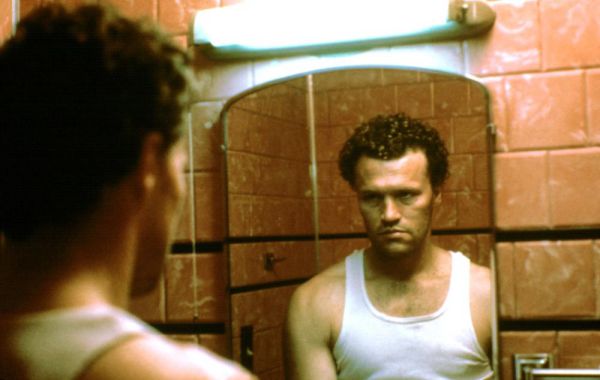Halloween Horror: Henry: Portrait of a Serial Killer (1986)
Henry: Portrait of a Serial Killer is a hard film to stomach. This is not just because of the brutal killings and rapes that constitute its subject matter, but also the way in which director John McNaughton conveys these actions. At the time critics compared Henry: Portrait of a Serial Killer to the work of John Cassavetes, indicating its low-key, naturalistic style. There’s a lived-in quality to the film, a casualness that, while not quite documentarian, makes the actions of Henry (Michael Rooker) and his bumbling subordinate, Otis (Tom Towles), all the more frightening for how mundane they are. It insinuates that the ordinary, unkempt, disgruntled people you pass in the street might be committing profoundly evil acts and that’d you never tell by just looking at them. This insinuation makes Henry: Portrait of a Serial Killer an insidious horror film and profoundly disturbing, even if it’s not scary in the traditional sense of making you cower in your seat.
The film is inspired by the real life serial killer Henry Lee Lucas and his associate Ottis Toole. Lucas claimed to have killed hundreds of people in random killings over the course of multiple decades—claims that were later refuted. However, the confessions stuck with director John McNaughton, who used them to fashion a film where the quiet, polite, but chilling drifter, Henry, kills dozens of people in a random, unmotivated fashion.
The film starts with images of two naked women. One lies dead in a field, another in a bathroom. Intercut with these ghastly images is Henry driving aimlessly around Chicago. Henry doesn’t live in Chicago. He’s only passing through, staying with Otis, a small-time drug dealer whom he served time with in prison. Otis’s sister, Becky (Tracy Arnold), is also staying at the dingy little apartment where the men hole up, having left her abusive husband and dropped her kid off with her mother. Becky finds the quiet Henry a welcome break from both her abusive husband and her oafish, sexually-aggressive brother, and a romance starts to blossom between the two. All the while, Henry starts to introduce Otis to his nighttime murdering sprees, taking him under his wing as a protégé.
The secret to the success of Henry: Portrait of a Serial Killer is two-fold. First is its dingy aesthetic. McNaughton shot in 16mm, and the noticeable grain of the celluloid adds to the film’s realism. The 16mm combined with McNaughton’s insistence on lived-in realism doesn’t give us the luxury of emotional and narrative distance from the film’s murder scenes. McNaughton shoots them much the same as he shoots the domestic moments: alternating between simple wide shots and unglamourous close-ups. In some ways, the film is a kitchen sink drama when it’s not a slasher film, following lower class individuals as they go about getting work and dealing through emotional trauma. There’s little visual difference between Henry and Otis invading a suburban home and murdering and violating the family within, and the men and Becky sharing a dinner in their apartment.
The only stylistic flourishes McNaughton allows are slow-moving dolly shots of Henry’s victims after he’s killed them. They’re stylish, for sure—perhaps even sensationalist, but to achieve a point of compassion. They fixate on the senseless death that Henry leaves in his wake, reminding the viewer of Henry’s crimes even as Henry goes about his day never thinking twice about his actions. They’re a necessary, albeit disturbing, corrective to his amorality, showing that the film isn’t indifferent even if the characters are.
The other aspect that makes Henry: Portrait of a Serial Killer so successful is that the film never portrays Henry as a cartoonish villain. This is a horror movie and Henry an undeniable horror villain, but he’s not a ghoul like Freddy Krueger, or even a satanic stand-in like Hannibal Lector. Henry is unknowable, his motivations mysterious, but he’s human. Rooker plays more facets than just a dead-eyed monster. He’s quiet and strange and you get a sense his brain doesn’t work quite right. It’s a great, terrifying performance.
We know Henry was abused as a child and that he served a sentence in prison because he killed his mother after years of repeated sexual harassment and abuse. We know that he’s fixated on politeness, scolding Otis for his vulgarity and sexual aggression with Becky. His relationship with Becky reveals his own past, and shows his conflicting relationship with vulnerable women: both wanting to protect them from their aggressors and preying on them due to his compulsive violence. Henry’s an evil man, but he attracts some of our empathy when compared to the lecherous fool, Otis. It makes him a deeper character than the average horror villain, both our de-facto protagonist and inarguable villain.
Henry: Portrait of a Serial Killer is a profoundly disturbing film, full of disgusting imagery and characters driven by unspeakable evil. But it’s also a human film, filmed on the level of the ordinary. And it’s that mundane vantage point that makes it so chilling.
8 out of 10
Henry: Portrait of a Serial Killer (1986, USA)
Directed by John McNaughton; written by Richard Fire and John McNaughton; starring Michael Rooker, Tom Towles, and Tracy Arnold.
